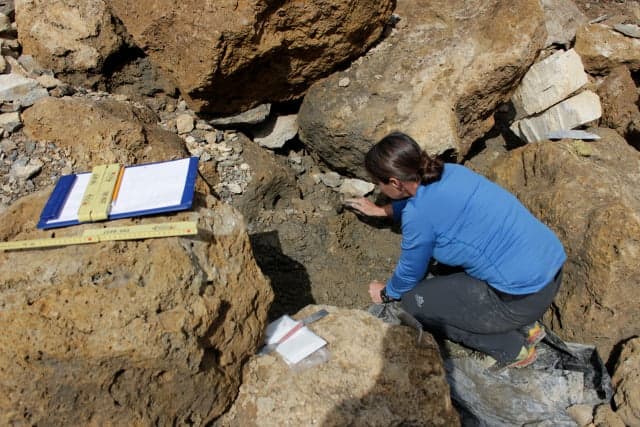Bronze Age equipment found on Swiss mountain pass

Flint arrowheads and leather fragments are among the 4,000 year-old items uncovered by archaeologists on the Lötschberg pass in the canton of Bern in September.
The lack of snow last winter followed by a hot summer left the Bronze Age items uncovered by snow and ice, allowing archaeologists to extract them for examination, the cantonal authorities said in a statement.
The area was identified as a site of interest in 2011, when the guardian of a cabin on the Lötschberg pass discovered several items following a significant snow melt and notified Bern’s archaeological service.
Several items were extracted in summer 2012, but the following four summers the area remained under snow. It wasn’t until this September that more remains were able to be excavated.
Among the total haul is a wooden box containing flour, fragments of bows, flint arrowheads, string made from animal fibre, a container made of cow horn and small pieces of leather.
The equipment has been carbon dated to around 2,000-1,800 years BC, suggesting it belonged to a mountain dweller from the Bronze Age.
The remains are the oldest ever found on the Lötschberg pass, though more recent items from the Roman era and the Middle Ages have previously been found there.
The recent discovery confirms that the pass has been used by hunters, shepherds and traders as a passageway between the Bernese Oberland and the Valais for at least 4,000 years.
This isn't the only find revealed by melting snow this year.
In July the bodies of a couple who disappeared in 1942 were found on the Tsanfleuron glacier in the Glacier 3,000 area.
And in August the remains of a German hiker who went missing in 1987 were unearthed on a glacier near Saas-Grund.
Comments
See Also
The lack of snow last winter followed by a hot summer left the Bronze Age items uncovered by snow and ice, allowing archaeologists to extract them for examination, the cantonal authorities said in a statement.
The area was identified as a site of interest in 2011, when the guardian of a cabin on the Lötschberg pass discovered several items following a significant snow melt and notified Bern’s archaeological service.
Several items were extracted in summer 2012, but the following four summers the area remained under snow. It wasn’t until this September that more remains were able to be excavated.
Among the total haul is a wooden box containing flour, fragments of bows, flint arrowheads, string made from animal fibre, a container made of cow horn and small pieces of leather.
The equipment has been carbon dated to around 2,000-1,800 years BC, suggesting it belonged to a mountain dweller from the Bronze Age.
The remains are the oldest ever found on the Lötschberg pass, though more recent items from the Roman era and the Middle Ages have previously been found there.
The recent discovery confirms that the pass has been used by hunters, shepherds and traders as a passageway between the Bernese Oberland and the Valais for at least 4,000 years.
This isn't the only find revealed by melting snow this year.
In July the bodies of a couple who disappeared in 1942 were found on the Tsanfleuron glacier in the Glacier 3,000 area.
And in August the remains of a German hiker who went missing in 1987 were unearthed on a glacier near Saas-Grund.
Join the conversation in our comments section below. Share your own views and experience and if you have a question or suggestion for our journalists then email us at [email protected].
Please keep comments civil, constructive and on topic – and make sure to read our terms of use before getting involved.
Please log in here to leave a comment.